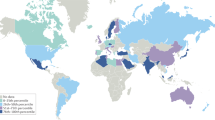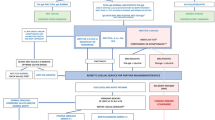Abstract
In the mid 1980s the incidence of coeliac disease in Swedish children below 2 years of age increased threefold within a few years, and after a 10-year high incidence period returned equally rapidly to the previous level. Analysing the epidemic with respect to any change in female to male ratio over time, or shift in age at diagnosis, may increase the understanding of coeliac disease aetiology. In a population-based incidence study of childhood coeliac disease, 2151 cases (811 boys/1340 girls) were diagnosed from 1973 to 1997. Incidence rates and relative risks (RRs) were calculated by gender, age at diagnosis and calendar time. Cumulative incidences by age and gender were calculated for different birth cohorts. A twofold higher risk (RR: 1.9, 95% confidence interval (CI) 1.7–2.1) for coeliac disease in girls as compared to boys prevailed throughout the epidemic. Further, during the post-epidemic period there was an upward shift in age at diagnosis. So far, however, a majority of the cases diagnosed at older ages belong to birth cohorts of the epidemic period, i.e. cohorts that already had a high coeliac disease risk before 2 years of age. Our results suggest that girls as compared to boys may be genetically more vulnerable to environmental exposures influencing the immunological processes towards coeliac disease. Further, an increased risk for coeliac disease during the first years of life due to, for example, unfavourable infant dietary habits, may result in an increased total childhood risk for coeliac disease. A longer follow-up, even into adulthood, is needed to determine whether or not the lifetime risk has changed.
Similar content being viewed by others
References
Mäki M, Collin P. Coeliac disease. Lancet 1997; 349: 1755–1759.
Murray JA. The widening spectrum of celiac disease. Am J Clin Nutr 1999; 69: 354–365.
Sollid LM. Molecular basis of celiac disease. Annu Rev Immunol 2000; 18: 53–81.
Schuppan D. Current concepts of celiac disease pathogenesis. Gastroenterology 2000; 119: 234–242.
Dieterich W, Ehnis T, Bauer M, et al. Identification of tissue transglutaminase as the autoantigen of celiac disease. Nat Med 1997; 3: 797–801.
Molberg O, Mcadam SN, Körner R, et al. Tissue transglutaminase selectively modifies gliadin peptides that are recognized by gutderived T cells in celiac disease. Nat Med 1998; 4: 713–717.
Marsh MN, Morgan S, Moriarty KJ, Ensari A. Intestinal lymphocyte responses to in vivo gluten challenge. In: Mäki M, Collin P, Visakorpi JK (eds), Coeliac Disease: Proceedings of the Seventh International Symposium on Coeliac Disease, Vammala, Finland: Vammalan Kirjapaino Oy, 1997: 125–137.
Arentz-Hansen H, Körner R, Molberg O, et al. The intestinal T cell response to alpha-gliadin in adult celiac disease is focused on a single deamidated glutamine targeted by tissue transglutaminase. J Exp Med 2000; 191: 603–612.
Anderson RP, Degano P, Godkin AJ, Jewell DP, Hill AV. In vivo antigen challenge in celiac disease identifies a single transglutaminase-modified peptide as the dominant A-gliadin T-cell epitope. Nat Med 2000; 6: 337–342.
Kagnoff MF, Paterson YJ, Kumar PJ, et al. Evidence for the role of a human intestinal adenovirus in the pathogenesis of coeliac disease. Gut 1987; 28: 995–1001.
Auricchio S, Follo D, De Ritis G, et al. Does breast feeding protect against the development of clinical symptoms of celiac disease in children? J Pediatr Gastroenterol Nutr 1983; 2: 428–433.
Stevens FM, Egan-Mitchell B, Cryan E, McCarthy CF, McNicholl B. Decreasing incidence of coeliac disease. Arch Dis Child 1987; 62: 465–468.
Greco L, Auricchio S, Mayer M, Grimaldi M. Case control study on nutritional risk factors in celiac disease. J Pediatr Gastroenterol Nutr 1988; 7: 395–399.
Mäki M, Holm K, Ascher H, Greco L. Factors affecting clinical presentation of coeliac disease: Role of type and amount of gluten-containing cereals in the diet. In: Auricchio S, Visakorpi JK (eds), Common Food Intolerances 1: Epidemiology of Coeliac Disease, Basel: Karger, 1992: 76–82.
Fälth-Magnusson K, Franzén L, Jansson G, Laurin P, Stenhammar L. Infant feeding history shows distinct differences between Swedish celiac and reference children. Pediatr Allergy Immunol 1996; 7: 1–5.
Challacombe DN, Mecrow IK, Elliott K, Clarke FJ, Wheeler EE. Changing infant feeding practices and declining incidence of celiac disease in West Somerset. Arch Dis Child 1997; 77: 206–209.
Ascher H, Kristiansson B. The highest incidence of celiac disease in Europe: The Swedish experience. J Pediatr Gastroenterol Nutr 1997; 24: 3–6.
Ivarsson A, Persson LÅ, Nyström L, et al. Epidemic of coeliac disease in Swedish children. Acta Paediatr 2000; 89: 165–171.
Ivarsson A, Hernell O, Stenlund H, Persson LÅ. Breast-feeding protects against celiac disease. Am J Clin Nutr 2002; 75: 914–921.
Ivarsson A, Persson LÅ, Hernell O. Does breast-feeding affect the risk for coeliac disease? In: Koletzko B, Michaelsen KF, Hernell O (eds), Short and Long Term Effects of Breast Feeding on Child Health, New York: Kluwer Academic/Plenum Publishers, 2000: 139–149.
Grodzinsky E, Franzen L, Hed J, Ström M. High prevalence of celiac disease in healthy adults revealed by antigliadin antibodies. Ann Allergy 1992; 69: 66–70.
Catassi C, Rätsch I-M, Fabiani E, et al. Coeliac disease in the year 2000: Exploring the iceberg. Lancet 1994; 343: 200–203.
Not T, Horvath K, Hill ID, et al. Celiac disease risk in the USA: High prevalence of antiendomysium antibodies in healthy blood donors. Scand J Gastroenterol 1998; 33: 494–498.
Uibo O, Uibo R, Kleimola V, Jogi T, Mäki M. Serum IgA anti-gliadin antibodies in an adult population sample. High prevalence without celiac disease. Dig Dis Sci 1993; 38: 2034–2037.
Catassi C, Rätsch IM, Gandolfi L, et al. Why is coeliac disease endemic in the people of the Sahara? [letter]. Lancet 1999; 354: 647–648.
Troncone R, Greco L, Auricchio S. The controversial epidemiology of coeliac disease [comment]. Acta Paediatr 2000; 89: 140–141.
Ivarsson A, Persson LÅ, Stenhammar L, Hernell O. Is prevention of coeliac disease possible? [letter] Acta Paediatr 2000; 89: 749–750.
Mäki M, Holm K. Incidence and prevalence of coeliac disease in Tampere: Coeliac disease is not disappearing. Acta Paediatr Scand 1990; 79: 980–982.
Greco L, Mäki M, Di Donato F, Visakorpi JK. Epidemiology of coeliac disease in Europe and the Mediterranean area. A summary report on the multicentre study by the European Society of Paediatric Gastroenterology and Nutrition. In: Auricchio S, Visakorpi JK (eds), Common Food Intolerances 1: Epidemiology of Coeliac Disease, Basel: Karger, 1992: 25–44.
Logan RFA, Rifkind EA, Busuttil A, Gilmour HM, Ferguson A. Prevalence and ‘incidence’ of celiac disease in Edinburgh and the Lothian region of Scotland. Gastroenterology 1986; 90: 334–342.
Ciacci C, Cirillo M, Sollazzo R, Savino G, Sabbatini F, Mazzacca G. Gender and clinical presentation in adult celiac disease. Scand J Gastroenterol 1995; 30: 1077–1081.
Collin P, Reunala T, Rasmussen M, et al. High incidence and prevalence of adult coeliac disease. Augmented diagnostic approach. Scand J Gastroenterol 1997; 32: 1129–1133.
Catassi C, Fabiani E, Rätsch IM, et al. The coeliac iceberg in Italy. A multicentre antigliadin antibodies screening for coeliac disease in school-age subjects. Acta Paediatr Suppl 1996; 412: 29–35.
Johnston SD, Watson RGP, McMillan SA, Sloan J, Love AHG. Coeliac disease detected by screening is not silent - simply unrecognized. QJM 1998; 91: 853–860.
Ivarsson A, Persson LA, Juto P, Peltonen M, Suhr O, Hernell O. High prevalence of undiagnosed coeliac disease in adults: A Swedish population-based study. J Int Med 1999; 245: 63–68.
Walker-Smith JA, Guandalini S, Schmitz J, Shmerling DH, Visakorpi JK. Revised criteria for diagnosis of coeliac disease. Report of Working Group of European Society of Paediatric Gastroenterology and Nutrition. Arch Dis Child 1990; 65: 909–911.
EXCEL 97. Microsoft Corporation, 1997.
SPSS Inc. Statistical package for the social sciences, version 9.0. Chicago, USA: SPSS Inc, 1999.
Cytel Software Corporation. EGRET for Windows. Epidemiological graphics, estimation and testing package. Cambridge, MA, USA: Cytel Software Corporation, 1999.
Ventura A, Magazzu G, Greco L. Duration of exposure to gluten and risk for autoimmune disorders in patients with celiac disease. SIGEP Study Group for Autoimmune Disorders in Celiac Disease. Gastroenterology 1999; 117: 297–303.
Whitacre CC, Reingold SC, O'Looney PA. A gender gap in autoimmunity. Science 1999; 283: 1277–1278.
Becker KG, Simon RM, Bailey-Wilson JE, et al. Clustering of non-major histocompatibility complex susceptibility candidate loci in human autoimmune diseases. Proc Natl Acad Sci USA 1998; 95: 9979–9984.
Furuya T, Salstrom JL, McCall-Vining S, et al. Genetic dissection of a rat model for rheumatoid arthritis: Significant gender influences on autosomal modifier loci. Hum Mol Genet 2000; 9: 2241–2250.
Author information
Authors and Affiliations
Rights and permissions
About this article
Cite this article
Ivarsson, A., Persson, L.Å., Nyström, L. et al. The Swedish coeliac disease epidemic with a prevailing twofold higher risk in girls compared to boys may reflect gender specific risk factors. Eur J Epidemiol 18, 677–684 (2003). https://doi.org/10.1023/A:1024873630588
Issue Date:
DOI: https://doi.org/10.1023/A:1024873630588




